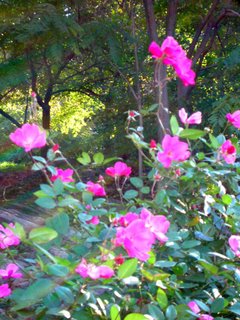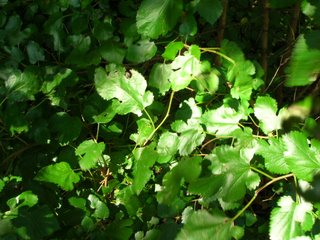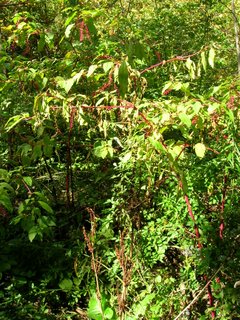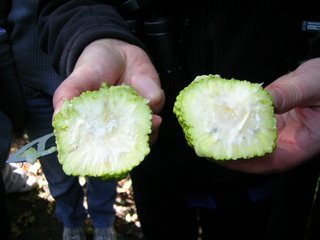THE GINKO FAMILY
These trees are in one family. The one all the way on the left id the male. The one in the center is the female. The female has fruits. The one on the right is a juvenile female ginko tree. Nature has many different genders. You can identify the differences by looking for fruits or other obvious differences.

This flower has color. The reason why this plant is pink is because we can see pink. This adaptaion is produced by the plant. Not many other animal can see colors. The animal that uses this plant can also see pink.

This is a plant that has migrated over from Ireland. This is a clover.

This is a plant that helps out people with arthritis pain.

This is a silk worm plant. When the silk moth lays its larve, it usally lays it on this plant. Because of industrial pollution, the dose of poisin in this plant has increased. If a silk worm eat this leaf, it is going to die.

This is a plant that has been altered by nature. There are purple fruits on this plant. When a parrot eat this fruit, it is going to get poisened.

This is a mushroom on the top of Inwood Hill Park. It stands alone and its poisenous.

During our visit in Inwood Park, we found the Golden Rod. A yellow, golden flower that is rarely seen during Mid-October.

This is compost. Compost is a way to recycle dead resources. Decomposers turn this into fertle soil.

This is one of the decomposers that help the compost. It is an Earthworm.

This is an Osage Fruit. It looks like a disembouglated tennis ball. The fruit smells like a citrus fruit.

This is a remains of the last glacier retreat. This is a geyser.

This flower has color. The reason why this plant is pink is because we can see pink. This adaptaion is produced by the plant. Not many other animal can see colors. The animal that uses this plant can also see pink.

This is a plant that has migrated over from Ireland. This is a clover.

This is a plant that helps out people with arthritis pain.

This is a silk worm plant. When the silk moth lays its larve, it usally lays it on this plant. Because of industrial pollution, the dose of poisin in this plant has increased. If a silk worm eat this leaf, it is going to die.

This is a plant that has been altered by nature. There are purple fruits on this plant. When a parrot eat this fruit, it is going to get poisened.

This is a mushroom on the top of Inwood Hill Park. It stands alone and its poisenous.

During our visit in Inwood Park, we found the Golden Rod. A yellow, golden flower that is rarely seen during Mid-October.

This is compost. Compost is a way to recycle dead resources. Decomposers turn this into fertle soil.

This is one of the decomposers that help the compost. It is an Earthworm.

This is an Osage Fruit. It looks like a disembouglated tennis ball. The fruit smells like a citrus fruit.

This is a remains of the last glacier retreat. This is a geyser.



